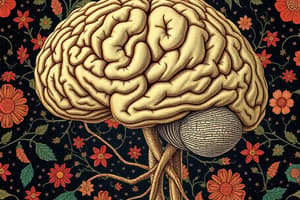Podcast
Questions and Answers
What is the primary function of the fore-brain?
What is the primary function of the fore-brain?
- Regulate heart rate and breathing
- Control involuntary muscle movements
- Facilitate reflex actions
- Interpret sensory information (correct)
Which part of the nervous system connects the central nervous system to the rest of the body?
Which part of the nervous system connects the central nervous system to the rest of the body?
- Somatic nervous system
- Peripheral nervous system (correct)
- Autonomic nervous system
- Sensory nervous system
How does the fore-brain process sensory information?
How does the fore-brain process sensory information?
- By sending impulses directly to muscles
- Using feedback from the spinal cord
- Through areas that interpret combinations of sensory inputs (correct)
- By generating reflex actions autonomously
What role do the motor areas of the fore-brain play?
What role do the motor areas of the fore-brain play?
What sensation is specifically associated with the fore-brain in terms of hunger?
What sensation is specifically associated with the fore-brain in terms of hunger?
What is the primary function of abscisic acid in plants?
What is the primary function of abscisic acid in plants?
What role does adrenaline play in animal behavior during high-stress situations?
What role does adrenaline play in animal behavior during high-stress situations?
How do chemical signals compare to electrical impulses in animal responses?
How do chemical signals compare to electrical impulses in animal responses?
Which hormone is responsible for triggering a fight-or-flight response in animals?
Which hormone is responsible for triggering a fight-or-flight response in animals?
What might be a consequence of relying solely on electrical impulses for responses in animals?
What might be a consequence of relying solely on electrical impulses for responses in animals?
What part of the brain is primarily responsible for involuntary actions such as blood pressure and salivation?
What part of the brain is primarily responsible for involuntary actions such as blood pressure and salivation?
Which function is the cerebellum primarily responsible for?
Which function is the cerebellum primarily responsible for?
How does the brain receive protection from physical damage?
How does the brain receive protection from physical damage?
What is the role of nervous tissue in the body?
What is the role of nervous tissue in the body?
Which of the following movements is controlled by the hind-brain?
Which of the following movements is controlled by the hind-brain?
How do muscle cells change their shape to enable movement?
How do muscle cells change their shape to enable movement?
What distinguishes voluntary muscles from involuntary muscles?
What distinguishes voluntary muscles from involuntary muscles?
What occurs at the synapse between two neurons?
What occurs at the synapse between two neurons?
How do plants respond to stimuli without a nervous system?
How do plants respond to stimuli without a nervous system?
What is the primary function of the brain in reflex action?
What is the primary function of the brain in reflex action?
What role does the pancreas play in blood sugar regulation?
What role does the pancreas play in blood sugar regulation?
Which hormone is primarily involved in the feedback mechanism for blood sugar regulation?
Which hormone is primarily involved in the feedback mechanism for blood sugar regulation?
What characterizes the responses of the nervous system?
What characterizes the responses of the nervous system?
How do hormones achieve their effects in the body?
How do hormones achieve their effects in the body?
What is a common treatment for patients with diabetes?
What is a common treatment for patients with diabetes?
Flashcards are hidden until you start studying
Study Notes
Nervous System Overview
- The central nervous system (CNS) communicates with the body via the peripheral nervous system (PNS), which consists of cranial and spinal nerves.
- The brain integrates various inputs and outputs through its division into three main regions: fore-brain, mid-brain, and hind-brain.
Fore-Brain Functions
- The fore-brain is the principal region for thinking and processing sensory information from receptors.
- Different areas specialize in senses such as hearing, smell, and sight, facilitating interpretation and response formation.
- Additional areas in the fore-brain manage hunger sensations, determining when one feels full.
Reflex Actions and Voluntary Movements
- Reflex actions (e.g., salivation or pupil size adjustments) occur without conscious thought, governed by the mid-brain and hind-brain.
- Voluntary actions (e.g., walking, picking up objects) depend on the cerebellum in the hind-brain, which ensures body balance and posture.
Brain Protection
- The brain is encased in a bony skull and a fluid-filled membrane for shock absorption.
- The vertebral column safeguards the spinal cord, supporting overall nervous system protection.
Muscle Movement Mechanism
- Muscle movement results from nerve impulses causing muscle fibers to alter shape.
- Special proteins within muscle cells reorganize themselves in response to electrical impulses, leading to muscular contraction.
Coordination in Plants
- Plants lack a nervous system but respond to stimuli through hormonal signals and rapid movements.
- Examples include the quick folding of sensitive plant leaves upon touch and directional growth in response to environmental cues.
Hormonal Coordination in Animals
- Hormonal signals, such as adrenaline, prepare the body for demanding activities, enhancing energy efficiency.
- Hormones reach various tissues to coordinate physiological responses, influenced by feedback mechanisms for regulation.
Key Concepts in Control and Coordination
- Control and coordination are essential functions of the nervous system and hormonal systems.
- Responses can be categorized into reflex, voluntary, and involuntary actions, with the nervous system relaying messages through electrical impulses.
- Hormones play a crucial role in chemical coordination, traveling from one part of an organism to another to achieve effects, governed by feedback mechanisms for precise regulation.
Studying That Suits You
Use AI to generate personalized quizzes and flashcards to suit your learning preferences.




